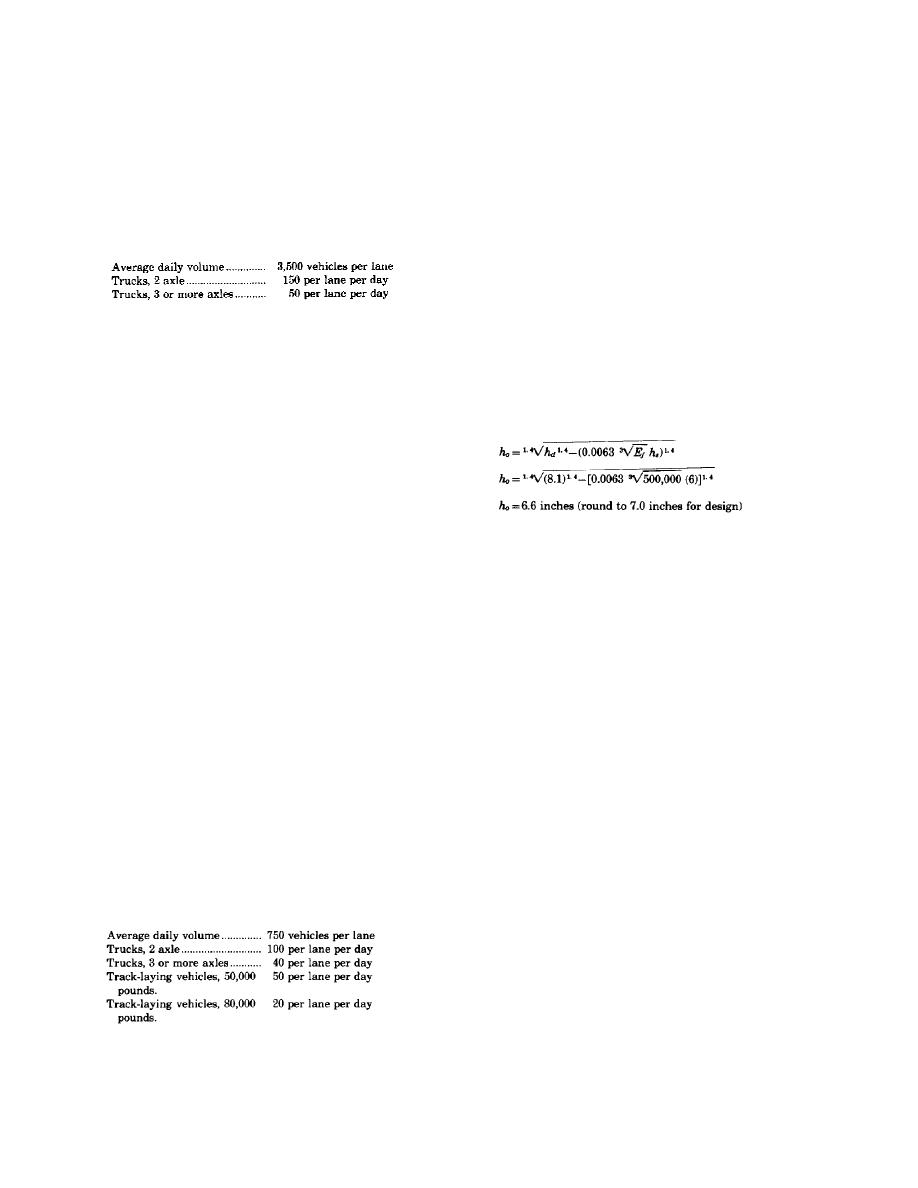
TM 5-822-5/AFM 88-7, Chap. 1
For additional information on stabilization and mix
chapter 3, the 50-kilopounds (kip) tracked vehicles
proportioning see TM 5-822-4 and TM 5-818-1.
would be classified as category V traffic. For a fire-
quench of 50 of these vehicles per lane per day, the
pavement design index would be 6. The 80-kip
12-5. Design Examples.
tracked vehicles are classified as category VI traffic.
As an example of the application of the design pro-
For a frequency of 20 of these vehicles per lane per
cedures given for nonstabilized foundations, design
day, the pavement design index would be 7. Thus,
a plain concrete pavement for a road in a rural area
it can be seen that the 80-kip tracked vehicle traffic
on rolling terrain to carry the following traffic:
governs as it requires the highest design index.
Assuming the same 28-day flexural strength and k
value as in the previous design examples, the
required pavement thickness is 8.1 inches (fig 12-1)
which would be rounded to 8.5 inches for design.
Based on the criteria in TM 5-822-2/AFM 88-7,
For this same example, if the plain concrete
Chap 5, this traffic would be evaluated as requiring
pavement is to be placed on 6 inches of cement
a class C road. It would be designed for category
stabilized soil having an E~ value of 500,000 psi,
IV traffic and a design index of 5. Assuming a 28-
then the thickness of plain concrete re- quire would
day flexural strength for the concrete of 675 psi,
be as follows using equation 12-1.
and a k value of 100 pounds per cubic inch (pci),
the required pavement thickness as indicated by
figure 12-1 is approximately 7.3 inches. This thick-
ness value would be rounded off to 7.5 inches for
design. To illustrate the design procedure when
traffic includes tracked vehicles, assume that in
Design examples for rigid pavement for frost con-
addition to the pneumatic-tired traffic used in the
ditions are discussed in chapter 18.
previous example, the designer must provide for an
average of 60 tanks per lane per day and that the
12-6. Concrete Sidewalks.
gross weight of each tank is 50,000 pounds. The
50,000-pounds gross weight would be classified as
Portland cement concrete walks may be provided at
category V traffic (according to chapter 3) since it
installations where pedestrian traffic justifies this
exceeds the maximum of 40,000 pounds permitted
type of construction. Normally, the design thickness
for tracked vehicles in category IV traffic. Inasmuch
for walks will be 4 inches. Where it is necessary and
as the tank traffic exceeds 40 per day, the rigid
desirable to continue the walk across driveways and
pavement design index would be based on the next
private entrances, provided for vehicle crossings,
higher traffic volume given in table 3-1, which is
the thickness of the walk should be increased to
100 per day. Thus, the design index for a class C
provide sufficient strength to support the vehicular
street would be 6. Assuming the same 28-day
loads to which such portions of the walks will be
flexural strength and k value as in the previous
subjected. Concrete walks should be grooved
example, the required pavement thickness is
transversely into rectangular areas with the longest
approximately 7.75 inches (fig 12-1) and would re-
dimension no greater than 1.25 times the shorter
quire a design thickness of 8.0 inches. To illustrate
dimension to create planes of weakness for control
the procedure for combining tracked vehicles with
of contraction cracking. The depth of such grooves
pneumatic-tired vehicles, design a rigid pavement
should be a minimum of one-fourth the thickness of
on rolling terrain for the following traffic:
the slab and need not be sealed. Expansion joints
consisting of approved preformed bituminous filler
or wood approximately inch thick should be
installed to surround or to separate all structures or
features which project through or against the
sidewalk slab. Expansion joints of a similar type
should be installed at regularly spaced intervals
transversely across the sidewalk slab. The spacing
According to TM 5-822-2/AFM 88-7, Chap 5, the
for such joints should be not less than 30 feet nor
traffic on rolling terrain would be evaluated as re-
more than 50 feet. A base is only recommended at
quiring a class D road or class E street. From
locations where past experience has shown that sub-
12-4



 Previous Page
Previous Page
